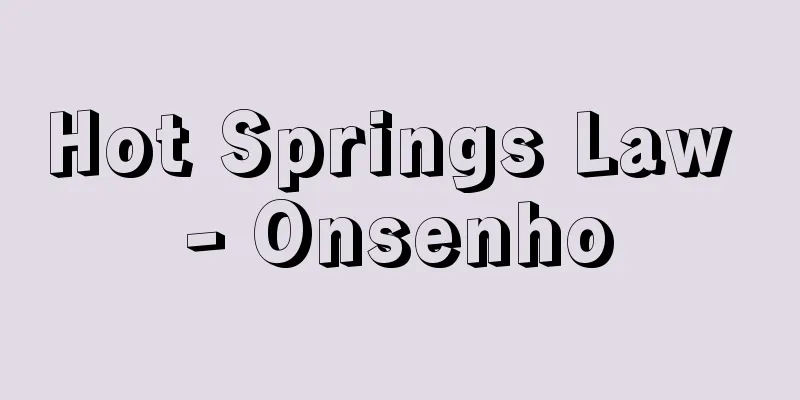Hot Springs Law - Onsenho

|
This law was enacted in July 1948 (Showa 23) (Law No. 125 of 1948) with the objectives of "protecting hot springs, preventing disasters caused by flammable natural gas generated during the collection of hot springs, and ensuring the proper use of hot springs." It came into effect in August of the same year. This law defines "hot springs" as "hot water, mineral water, steam, and other gases that well up from the ground" that has a temperature of 25°C or higher or that contains substances specified by law. From the perspective of "protecting hot springs," permission from the prefectural governor is required when digging land to make hot springs flow, when digging additional drainage channels, and when installing power sources to increase the amount of hot spring water. Regarding "use of hot springs," permission from the prefectural governor is also required when making hot springs available for public bathing or drinking, and labeling of the hot spring ingredients, etc. is also mandatory. In the summer of 2004, it was discovered that hot springs all over Japan were using coloring agents and boiled tap water. As a result, the Enforcement Regulations of this Law were revised in February 2005, and in addition to the existing obligation to display information about the hot spring ingredients, it was made mandatory to also display information about the condition of the hot spring in the bath, such as the addition of water, heating, use of circulation devices, and the use of bath additives, as well as to analyze the hot spring ingredients every 10 years. Furthermore, following an explosion at a hot spring facility in Tokyo's Shibuya Ward in June 2007, the law was amended in the same year to add the purpose of "preventing disasters caused by flammable natural gas generated during the collection of hot spring water," and a permit system was also introduced for the collection of hot spring water from hot spring sources. [Ken Tanaka] [Reference] | |Source: Shogakukan Encyclopedia Nipponica About Encyclopedia Nipponica Information | Legend |
|
「温泉を保護し、温泉の採取等に伴い発生する可燃性天然ガスによる災害を防止し、及び温泉の利用の適正」を図ることを目的として、1948年(昭和23)7月に制定された法律(昭和23年法律第125号)。同年8月施行。本法では、「温泉」を、25℃以上の温度または法に定める物質を有する「地中からゆう出する温水、鉱水及び水蒸気その他のガス」と定義している。 「温泉の保護」という視点から、温泉を湧出(ゆうしゅつ)させるために土地を掘削する場合、湧出路を増掘する場合、湧出量を増加させるために動力を設置する場合には、都道府県知事の許可が必要とされる。「温泉の利用」について、温泉を公共の浴用・飲用に供しようとする場合も、都道府県知事等による許可が必要とされるほか、温泉成分等の表示についても義務づけている。 2004年(平成16)夏に、日本各地の温泉で、着色剤の使用や水道水を沸かしたお湯の使用などが判明したこともあり、2005年2月に本法施行規則が改正され、従来の温泉成分に関する表示義務に加え、加水、加温、循環装置の利用、入浴剤の利用など浴槽内の温泉の状況についても表示を義務付けたほか、10年以内ごとの温泉成分分析も義務付けた。 さらに、2007年6月に東京都渋谷区の温泉施設で発生した爆発事故を受けて、同年に法律が改正され、「温泉の採取等に伴い発生する可燃性天然ガスによる災害を防止」することが目的に加えられたほか、温泉源からの温泉の採取に対しても許可制度が導入された。 [田中 謙] [参照項目] | |出典 小学館 日本大百科全書(ニッポニカ)日本大百科全書(ニッポニカ)について 情報 | 凡例 |
<<: Hot spring name - Onsenmei (English)
Recommend
Overseas Broadcasting - Kaigai Hoso
Also known as international broadcasting. Broadcas...
Laozi - Laozi
Date of birth and death unknown. A person who is ...
OCA - Office Creation Association
Olympic Council of Asia. Established in 1982 as a ...
Dinner
…General term for insects belonging to the Brasso...
Wölfflin, Heinrich
Born: June 21, 1864, Winterthur Died: July 19, 194...
Kojiro Fukushi
Poet. Born in Hirosaki, Aomori Prefecture. Gradua...
Georg Weerth
1822‐56 German author. While helping edit the Köln...
Capitel
…the Roman Catholic Church is a body of the Churc...
Wakayama Prefecture
A prefecture in the southwest of the Kinki region....
Senyutei Senkyo
Rakugo performer. (1) The first (?-1829 (Bunsei 12...
Lightning Bolt
...Although he was not as strict as his contempor...
Oirot Yapon - Oirot Yapon
...The population in 1989 was 192,000, and the ca...
Aksum; Axum
An ancient city in the Tigray region of northern E...
scolex
…Adult worms that parasitize the human body usual...
Onuma Quasi-National Park
This quasi-national park is located in the southw...









